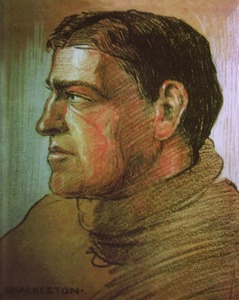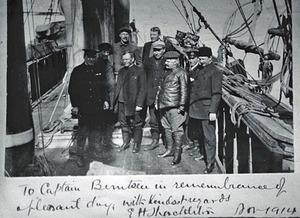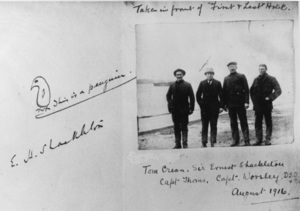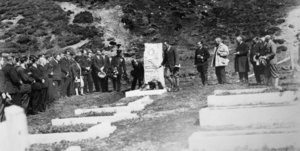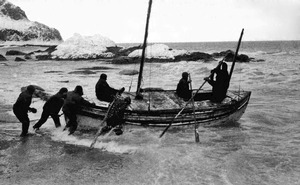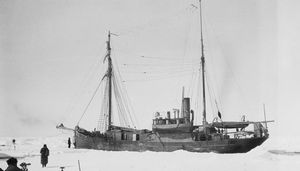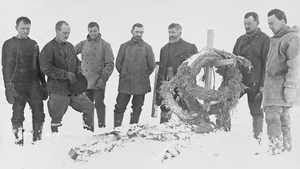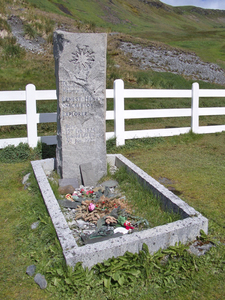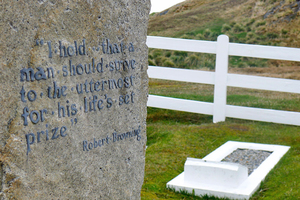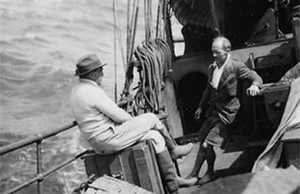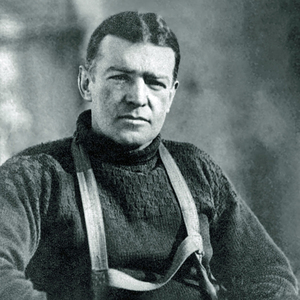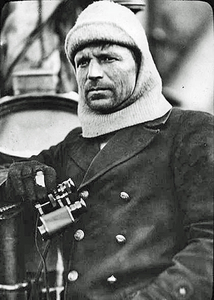SHACKLETON, Sir ERNEST HENRY (The Boss)
1874 - 1922 from Ireland
Anglo-Irish explorer, was born on 15 February 1874 at Kilkea in Co Kildare, Ireland, the second in a family of two sons and eight daughters born to Henry Shackleton and Henrietta, née Gavan. The Shackletons moved first to Dublin and then, in 1884, to London. In 1887 Shackleton entered Dulwich College but in 1890, aged 16, he left to become a boy on the sailing ship Hoghton Tower. His first voyage took him around Cape Horn to Valparaiso, Chile. In 1896, he qualified as first mate and two years later gained his master's certificate. He joined the Union Castle Line in 1899 and sailed as third officer on Tintagel Castle on trooping runs to Cape Town during the Boer War.
By using an introduction to Llewellyn Longstaff, a major benefactor of the National Antarctic Expedition (1901-1904) under the command of Robert Falcon Scott, Shackleton was able to obtain an appointment on RRS Discovery as third lieutenant in charge of holds, stores, provisions and seawater analysis. Discovery remained in the Antarctic and was used as the expedition base. This allowed Shackleton to take part in journeys of exploration. On November 2 1902 Scott, Edward Wilson and Shackleton set out on the centrepiece southern journey with the aim of getting as far south as possible - perhaps even to the South Pole. In the event, they were forced to turn for home on December 31, at 82°15', 480 statute miles from the Pole, having travelled 300 miles beyond the previous farthest south. All three men suffered from scurvy, with Shackleton suffering the most. Although he recovered well, he was invalided home, greatly disappointed, on the relief ship Morning.
The Nimrod Expedition
In early 1904, Shackleton was elected secretary to the Royal Scottish Geographical Society. This post enabled him to marry Emily Dorman, a friend of one of his sisters, whom he had met in 1897. They had three children, Raymond (b1905), Cecily (b1906) and Edward, later Lord SHACKLETON (b1911). Shackleton soon resigned from the RSGS in order to stand as a Unionist candidate for Dundee in the General Election, but he came fourth in the poll.
There followed a rather ill-defined sinecure with the industrialist William Beardmore who guaranteed a loan of £7000 which allowed Shackleton to launch the British Antarctic Expedition in February 1907. Put together in an amazingly short time, the expedition sailed on 7 August in the Dundee sealer Nimrod, having first visited Cowes, where King Edward VII inspected the ship and conferred the Royal Victorian Order on Shackleton, while Queen Alexandra gave him a flag.
As well as serious shortfalls in finance, Shackleton's expedition was hampered in executing its objectives of reaching the South Magnetic Pole as well as the geographical Pole by an agreement with Scott that he would not encroach on the McMurdo Sound area which the latter considered his preserve. Nimrod arrived at Lyttelton, New Zealand, and on November 23 was towed south by the steamer Koonya to save coal. Shackleton was unable to find a site for a base at the eastern end of the Ross Ice Shelf and had to turn back to McMurdo Sound. The shore party was landed at Cape Royds, close to the old Discovery headquarters at Hut Point. Shackleton's plan was to reach the South Pole with the aid of an Arrol-Johnston motorcar and a team of Manchurian ponies. Both means of transport failed to live up to expectation and Shackleton, with Frank Wild, Eric Marshall and Jameson Boyd Adams, were forced to drag their sledges on foot after the motor had broken down and the ponies had died or been killed. They reached 88°23'S, less than 100 miles from the Pole, before shortage of food forced them to retreat. If they had not lost the last pony down a crevasse, they would have had enough food to reach the Pole. As it was, they had a horrific trek back, suffering from starvation exacerbated by dysentery.
On 27 February, Marshall collapsed and, with Nimrod due to leave in two days, Shackleton and Wild set off on the last 33 miles to get help. They reached the Discovery hut to find it empty but next day attracted Nimrod's attention. Shackleton immediately set out with the rescue party and brought Adams and Marshall in. After all the privations of the 1500 mile trek, he had finally covered nearly 100 miles without proper sleep. A second party consisting of Edgeworth David, Douglas Mawson and Alistair Mackay attained the South Magnetic Pole and a party of six made the first ascent of Mt Erebus.
Shackleton's attempt on the South Pole was the essential journey of geographical discovery. He pioneered the route up the Beardmore Glacier and showed that the south polar region is a high ice-covered plateau. Covering the last 100 miles to reach the Pole would not add significantly to human knowledge. In his wife's words:
The only comment he made to me about not reaching the Pole was "a live donkey is better than a dead lion, isn't it?" and I said "Yes darling, as far as I am concerned" and we left it at that.
The expedition returned home in triumph. Shackleton had become a national hero and was knighted.
The Imperial Transantarctic Expedition - Endurance
Once again Shackleton failed to settle down, socially or professionally, and in December 1911 he announced plans for the Imperial Transantarctic Expedition to cross the continent from the Weddell Sea to the Ross Sea via the South Pole, a journey of about 1800 miles. A second sledging party would travel towards Graham Land and third would head eastward toward Enderby Land. From another base in McMurdo Sound, a support party would lay a depot at the top of the Beardmore Glacier for the transcontinental party to pick up.
The idea of crossing Antarctica was not original. It had been proposed by William Spiers BRUCE after his own expedition into the Weddell Sea but he could not raise the funds and agreed to Shackleton using his plan. Funding was also a problem for Shackleton but he eventually received £24,000 from the Scottish jute magnate Sir James Caird, £10,000 from the British government and lesser donations from Dudley Docker, Dame Janet Stancomb-Wills and Elizabeth Dawson-Lambton. Many public schools contributed to purchasing dogs. A Norwegian ship Polaris, strongly-built but not ideal for the expedition's purpose, was purchased for £11,600 and renamed Endurance (from the Shackleton family motto Fortitudine vincimus - By endurance we conquer).
The second ship Aurora was purchased for £3,200 from Douglas Mawson, the Australian explorer who had been on the Nimrod expedition. Preparations were rushed and in places skimped, but Shackleton engaged the Army's nutrition expert, Colonel Wilfred Beveridge, to devise nutritious sledging rations to prevent scurvy, arranged for 100 sledge dogs to be brought over from Canada and devised propeller-driven sledges.
Endurance sailed from England at the outbreak of World War I. On hearing that general mobilisation had been ordered, Shackleton put the resources of the expedition at the disposal of the Admiralty. The reply came in a one-word telegram - Proceed - which was backed up by a letter from Winston Churchill. Shackleton also received support from King GEORGE V. However, he continued to be concerned that he should not be leaving the country at such a time.
Shackleton joined Endurance at Buenos Aires on 27 September. There he announced that he would sail to South Georgia rather than the Falkland Islands. His appearance at Grytviken on 5 November surprised the Norwegian whalers. They advised him that he should delay his departure for the Weddell Sea because it was a bad year for pack-ice. During their month's stay, Endurance visited several of the whaling stations, taking on coal and other supplies, and the scientists were able to work ashore. The expedition finally set sail on 5 December and in three days reached the edge of the pack-ice. Coats Land on the southern coast of the Weddell Sea was sighted on 10 January. Shackleton was heading for the farthest south, Vahsel Bay, to reduce the length of the continental crossing, but he never got there. Endurance was beset in ice 25 miles away and, when it was clear they would not get clear, ship's routine was abandoned and the company prepared for a long winter.
The salvation of the expedition lay in the Weddell Gyre, the ocean current that circulates clockwise in the Weddell Sea. Endurance slowly drifted northwards with Shackleton exercising his powers of leadership to maintain morale during the long Antarctic night and as the pressure of the ice-floes started to batter Endurance. Eventually, she sprang a leak and, when timbers began to crack, the men abandoned ship and set up 'Dump Camp' in tents on an ice-floe. Shackleton had several options. One was to cross the coast of Graham Land (now the Antarctic Peninsula) and sail in search of the Norwegian whalers who operated in the sheltered waters on the west coast. The best option was to head for Paulet Island and thence to the whaling station on Deception Island. Paulet Island had been the refuge of the crew of Antarctic, the ship of Otto NORDENSKJÖLD's Swedish expedition, after it had been crushed by ice in 1902. They had not only built a solid hut but, when helping to organise their relief, Shackleton had suggested leaving any unused stores for future emergencies. It would have been a nice story if he had benefited from his own foresight!
Three days later, the party set out dragging two boats on sledges in the direction of Grahamland. Conditions underfoot forced them to give up after they had moved only 1½ miles so a more permanent camp, Ocean Camp, was established on a large ice-floe. The wreck of Endurance was raided for more food and equipment and the men lived in reasonable comfort as the northward drift continued. Nevertheless, Shackleton trained the men in emergency procedures in case the floe broke up or pressure rafted more floes over it. By late December the floe was starting to disintegrate and another attempt was made at travelling. This time they kept going for a week until compelled to make camp again. This was aptly named Patience Camp because they were now forced to stay put until the pack-ice opened and they could take to the boats. Travel over the floes had become too dangerous to risk visiting Ocean Camp to collect the gear they had left behind, except for a dash to get the third boat.
Patience Camp was abandoned on 9 April, at the end of the Antarctic summer, when they were about 60 miles from Paulet Island. The three boats, James Caird, Dudley Docker and Stancomb-Wills, were launched and the crews threaded their way between the floes. The next six days formed the nadir of the expedition. The men became severely debilitated as they suffered from seasickness, hunger, thirst, fatigue, frostbite and fear. At times the boats were nearly swamped or were driven by currents away from their destination. Shackleton decided that a landfall on inhospitable Elephant Island was essential before some men succumbed but this was not easy to achieve. Almost miraculously, all three boats made landfall at Cape Valentine. However, the small beach was backed by cliffs and gave no shelter from storms so the party moved to Point Wild.
The Epic Journey to South Georgia - James Caird
From Elephant Island, Shackleton set out in the 22 foot James Caird with Worsley, Crean, McNish, McCarty and Vincent on one of the most famous boat journeys in history. Battling high seas and ferocious storms and suffering immense privations they took 16 days to reach King Haakon Bay on the south-west coast of South Georgia.
The whaling stations lay on the other side of the Island and both the men and their boat were too frail to sail round the island so Shackleton, Worsley and Crean walked across it. The interior of the island was unknown and they had hopes of finding an easy route but mountains and glaciers lay in the way. Ill-equipped and untrained for mountaineering, but with sheer determination and immense luck with the weather, the trio found a route that led them to Stromness whaling station in a gruelling 36 hour trek. They were taken to the manager Thoralf SØRLLE, who failed to recognise them at first but then welcomed them in for baths, a change of clothes and dinner. While Shackleton and Crean went to bed in the manager's house, Worsley was despatched in the whalecatcher Samson to fetch the other three who were camping under the upturned James Caird on the shores of King Haakon Bay. A hint of the effect of the ordeal is shown in a letter from Søren BERNTSEN, manager of the Husvik whaling station, in which he describes Crean and Shackleton crying out in their sleep as they relived the James Caird's voyage.(at the time Worsley was off in the Samson collecting the three men left at King Haakon Bay).
The whalecatcher Southern Sky was hastily fitted out to relieve the men on Elephant Island. Captain Ingvar Thom, captain of the transport ship Orwell, was in command and, accompanied by Shackleton, Worsley and Crean, set out on 23 May. Seventy miles from the island the pack-ice forced them to retreat. They returned to Stanley where Shackleton would have access to the telegraph, arriving on 31 May. According to the magazine John Bull, Shackleton was not well received in Stanley: ' ...not a soul seemed to care one scrap!...An old kelper remarked, "'E ought ter 'ave been at the war long ago instead of messing about on icebergs." This was a journalist's invention. Other sources record an enthusiastic welcome by the Falkland Islanders similar to those of the Norwegians and later the Chileans. The account was clearly incorrect in describing Shackleton arriving on Southern Sky with a beard and shoulder-length hair. In a later issue, John Bull had to explain 'In view of the controversy excited by a recent article we point out...(the) Expedition's departure at mobilisation was requested by Admiralty and the King.'
However, Shackleton was well received by the governor, Douglas YOUNG, who invited him to stay at Government House. Thom took Southern Sky back to South Georgia to rejoin his own ship Orwell. He returned to Port Sunlight, Liverpool, taking McNish, MacCarthy and Vincent, and the James Caird. Shackleton's frustrations continued. The British Government reluctantly sanctioned the fitting-out of Discovery for a relief expedition but it would take months for her to reach Elephant Island. So Shackleton determined to continue his own attempts at rescue. While telegrams were exchanged with the outside world, Shackleton could only wait. He wrote that his chief distraction was to walk along the front at Stanley, from the slaughterhouse to the graveyard and, for a change, from the graveyard to the slaughterhouse.
Several offers of help were made and the Uruguayan Government loaned Shackleton the trawler Instituto de Pesca No 1 but the ice turned it away in sight of Elephant Island. They returned to Stanley and sailed for Punta Arenas, Chile, where British and Chilean residents donated £1500 to charter the 75 ton schooner Emma. Emma was towed part of the way by Yelcho, a small steamer, but was stopped by ice 100 miles short of Elephant Island Once again there was a return to Stanley where it was reported that Shackleton had to be helped ashore 'suffering from rheumatics and cramps from the exposure, damp, worry and anxiety'. Emma was then escorted back to Punta Arenas by Yelcho with Shackleton on board. The Chilean Government now loaned Yelcho, under the command of Captain Luis Pardo, for a fourth attempt, which was successful. The stranded men had lived a precarious life on Elephant Island for 105 days.
This was not the conclusion of the Imperial Transantarctic Expedition. The fate of the Ross Sea party was unknown. They became known as 'Shackleton's Forgotten Men' because their tribulations have been overshadowed by the story of the Endurance. Aurora had set sail from Hobart on 24 December 1914, ill-equipped and underfunded. It arrived at Cape Evans on 16 January 1916. It was late in the season but it was not known when Shackleton's transcontinental party might appear. So, despite several setbacks and hardgoing, a depot was established at 80°S. Meanwhile, however, Aurora had been blown out to sea and could not get back. The men stranded on shore were left very short of provisions and equipment. They survived the winter and next summer they managed to lay another depot at the foot of the Beardmore Glacier. On the way back three men were lost: the Rev A Spencer-Smith died of scurvy, while Aeneas Mackintosh, the leader, and VG Hayward were lost when sea-ice was blown out. After the survivors had eked out another miserable winter, Aurora with Shackleton on board picked them up.
Although, at 42, Shackleton was exempt from military service, he was determined to serve but it was difficult to find him a suitable role. He was sent to Buenos Aires for a short period on a propaganda mission to bolster the allied cause and on his return he was gazetted major to act as equipment officer at Murmansk for a British expeditionary force fighting the Bolsheviks. Also present were Worsley, Macklin and Hussey from Endurance, as well as men from Scott's expeditions. After five months, (October 1918 - February 1919) Shackleton was back in England and demobilised. For half a year after the war, he lectured on the Endurance expedition and by 1920 was planning his next expedition. This was to explore the Canadian Arctic but expected support from the Canadian Government did not materialise. Instead, he decided to head south again. With the financial support of John Quiller Rowett, an old school friend, the aim of the Shackleton-Rowett expedition was to circumnavigate Antarctica and carry out oceanographic research.
The Last Expedition - Quest
Quest sailed from London on September 17, 1921 and reached South Georgia on 4 January. For Shackleton and Worsley it was a return to the scene of their desperate but triumphant crossing of the island eight years earlier. They found old friends among the whalers at Grytviken and prepared to celebrate a delayed Christmas. That night Shackleton suffered a fatal heart attack as Macklin was administering medicine. It was agreed that the expedition would continue under Wild's command while Shackleton's body was escorted back to England by Hussey. It was carried on the floating factory ship, Professor Gruvel to Montevideo. However, Lady Shackleton requested that her husband be buried at South Georgia and Hussey returned with the body on a British ship, Woodville. By this time, Quest and her crew had left for the Antarctic and Hussey was the only member of the expedition at Shackleton's funeral which was held on 5 March 1922, with the magistrate Edward BINNIE officiating. The present headstone of Scottish granite was brought down in 1928 and unveiled by the governor of the Falkland Islands, Sir Arnold HODSON. It bears a misquotation of words of Shackleton's favourite poet, Robert Browning: 'I hold that a man should strive to the uttermost for his life's set prize'.
Although Shackleton's reputation was for a long time eclipsed by Scott's, it has enjoyed a remarkable revival. It is not surprising that his death is now generally accepted as the final event in the Heroic Age of Antarctic Exploration. The origin of what the New Yorker described as 'Shackletonmania' is not clear. It was greatly enhanced by a spate of books and films but these were more the result of an increasing interest in the drama of the Endurance story and Shackleton's abilities as a leader. His style of leadership which emphasised his care for his men and easy communication with them, as well as the charm that captivated people of all ranks from Emperors to cab drivers, accords with modern concepts of leadership. Shackleton Schools teach leadership in the United States and books for business people extol leadership 'the Shackleton way'.
The explorer Apsley Cherry Garrard compared Shackleton with three other great Antarctic pioneers thus:
For a joint scientific and geographical piece of organisation, give me Scott; for a Winter Journey, Wilson; for a dash to the Pole and nothing else, Amundsen; and if I am in the devil of a hole and want to get out of it, give me Shackleton every time.
Editorial comment:
1. The sunken wreck of the Endurance was discovered in March 2022, in water 3008 metres deep, in the Weddell Sea, by a joint Falklands Maritime Heritage Trust and The National Geographic expedition. The wreck was found just four nautical miles from the location where her captain, Frank Worsley, had recorded her final demise when she was crushed in the ice. After completing the search, the wreck was left undisturbed, and the research team and expedition ship first visited South Georgia to pay their respects to Ernest Shackleton - where he was buried in 1922 - before returning to South Africa.
2. Mensum Bound, the Falklands-born Director of the expedition to locate the sunken ship says: 'We hope our discovery will engage young people and inspire them with the pioneering spirit, courage and fortitude of those who sailed Endurance to Antarctica. We pay tribute to the navigational skills of Captain Frank Worsley, the Captain of the Endurance, whose detailed records were invaluable in our quest to locate the wreck.'
External links
See: Sir Ernest Shackleton on board Endurance, 1914 - BFI National Archive
See: Ernest Shackleton inspects the Quest (Pathe video - no sound)
See: Shackleton's grave on South Geogia (YouTube video)
See: Frank Wild's ashes buried next to Shackleton's grave on South Georgia (Vimeo video)
See: Sir Ernest Shackleton - National Geographic (Video - with sound)
See The LOst ship : https://www.bbc.co.uk/news/articles/cd6qz387qjgo Courtesy of BBC
See: Wax cylinder recording of Shackleton speaking in 1910
See: Scott Polar Research Institute, Cambridge: Shackleton exhibition
References
Shackleton, Ernest; Heart of the Antarctic; London: William Heinemann; 1911
Shackleton, Ernest; South; London: Century Publishing. 1919 and 1982
Comments
Ben Hodges
2018-06-20 20:17:06 UTC
My great-grandfather was the Captain's Coxswain aboard HMS Glasgow and he met Shackleton in the Falkland Islands in January 1916 as recorded in his diary. Stating that he "looked none the worst following his terrible ordeal"
Revisions
August 2019 Four external links added
September 2019 Three additional photographs added; two references added; four external links added
December 2019 Four additional photographs added
March 2020 Text correction made.
May 2020 One external link added
August 2021 Text correction made.
March 2022 Two additional photographs added; two editorial comments added.
October 2024 Addition YouTube link added
